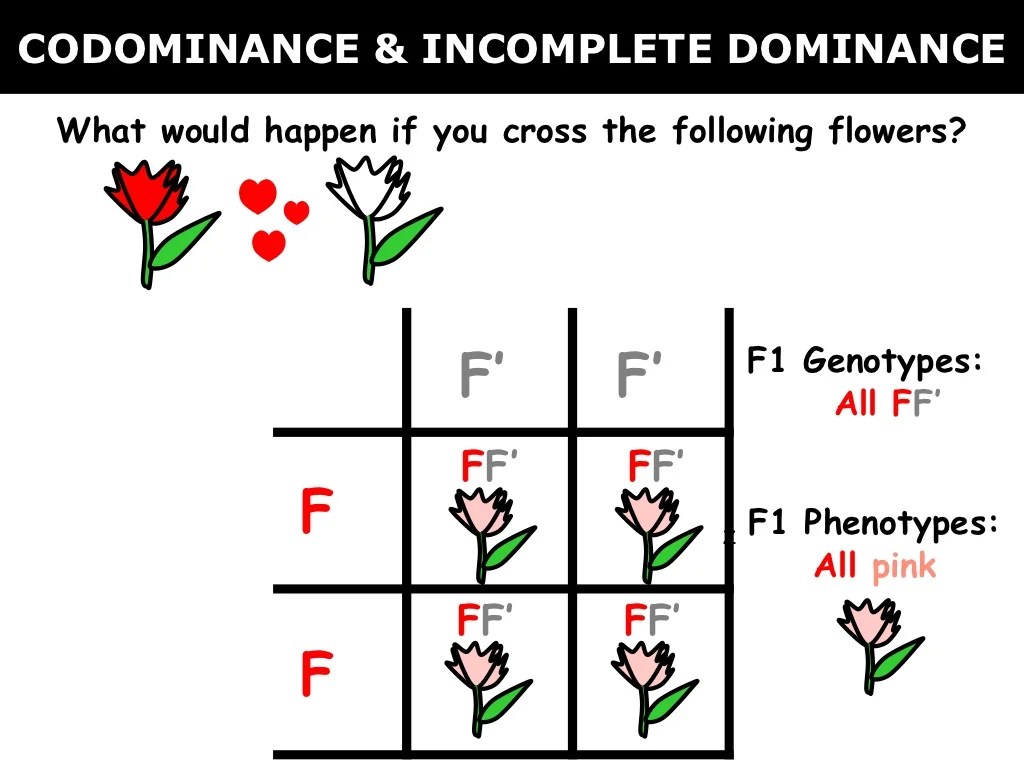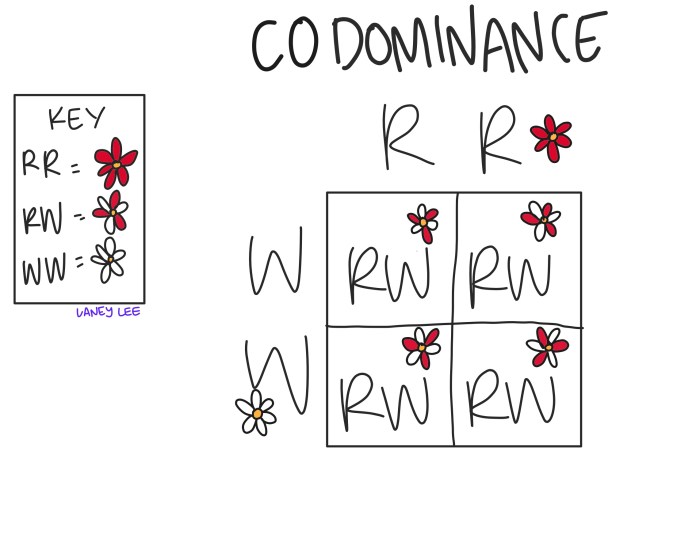Practice codominance and incomplete dominance, two captivating genetic phenomena, unravel the complexities of inheritance patterns. Codominance, where both alleles of a gene are fully expressed, and incomplete dominance, where neither allele is dominant, paint a vivid tapestry of genetic diversity.
Delving into the intricacies of these concepts, we embark on a journey to explore their genetic foundations, contrasting characteristics, and far-reaching applications in genetics, medicine, and agriculture.
Define Codominance: Practice Codominance And Incomplete Dominance

Codominance is a genetic phenomenon in which both alleles of a gene are fully expressed in the phenotype of a heterozygous individual. This means that neither allele is dominant over the other, and both contribute to the observable traits of the organism.
For example, in humans, the ABO blood type is determined by three alleles: A, B, and O. The A and B alleles are codominant, so individuals with the genotype AB have both A and B antigens on their red blood cells.
This results in the AB blood type, which is distinct from both the A and B blood types.
The genetic basis of codominance is the presence of two dominant alleles at a single gene locus. When both alleles are present in the heterozygous genotype, neither allele is able to suppress the expression of the other. As a result, both alleles are fully expressed in the phenotype.
Distinguish Codominance from Incomplete Dominance

Incomplete dominance is a genetic phenomenon in which neither allele of a gene is fully dominant over the other. This results in an intermediate phenotype in heterozygous individuals, which is a blend of the phenotypes associated with each allele.
For example, in snapdragons, the flower color is determined by two alleles: R (red) and W (white). The RR genotype produces red flowers, the WW genotype produces white flowers, and the RW genotype produces pink flowers, which is an intermediate phenotype.
The genetic basis of incomplete dominance is the presence of two incompletely dominant alleles at a single gene locus. When both alleles are present in the heterozygous genotype, neither allele is able to fully suppress the expression of the other.
As a result, both alleles are partially expressed in the phenotype, leading to an intermediate phenotype.
Mendelian Patterns of Inheritance

Mendelian patterns of inheritance are the basic principles of inheritance discovered by Gregor Mendel in the 19th century. These patterns describe how traits are passed from parents to offspring.
Codominance and incomplete dominance are two exceptions to Mendelian patterns of inheritance. In Mendelian inheritance, the phenotype of a heterozygous individual is typically either dominant or recessive. However, in codominance and incomplete dominance, the phenotype of a heterozygous individual is a blend of the phenotypes associated with each allele.
For example, in the ABO blood type system, the A and B alleles are codominant, so the heterozygous AB genotype results in the AB blood type, which is a blend of the A and B phenotypes. Similarly, in snapdragons, the R and W alleles are incompletely dominant, so the heterozygous RW genotype results in pink flowers, which is a blend of the red and white phenotypes.
Applications of Codominance and Incomplete Dominance

Codominance and incomplete dominance have a wide range of applications in fields such as genetics, medicine, and agriculture.
- In genetics, codominance and incomplete dominance are used to study the inheritance of traits and to map genes.
- In medicine, codominance and incomplete dominance are used to diagnose genetic disorders and to develop treatments.
- In agriculture, codominance and incomplete dominance are used to improve crop yields and to develop new varieties of plants.
For example, in cattle breeding, codominance is used to select for animals with desirable traits, such as increased milk production or resistance to disease. In medicine, incomplete dominance is used to diagnose genetic disorders, such as sickle cell anemia and cystic fibrosis.
In agriculture, incomplete dominance is used to develop new varieties of plants with improved traits, such as increased yield or resistance to pests.
Q&A
What is the key difference between codominance and incomplete dominance?
In codominance, both alleles are fully expressed, resulting in distinct phenotypes. In incomplete dominance, neither allele is dominant, leading to an intermediate phenotype.
Can codominance and incomplete dominance occur in the same organism?
Yes, different genes within an organism can exhibit either codominance or incomplete dominance.
How do codominance and incomplete dominance affect genetic diversity?
They increase genetic diversity by allowing for a wider range of phenotypes and reducing the likelihood of recessive alleles being masked.